What Domain Are Humans In
two.4: The Homo Animal
- Folio ID
- 16721
Relative to all animals, this child and monkey are practically "cousins." From genes to morphology to beliefs, they are similar in many means. That's considering both of them are primates, and they share an evolutionary past.
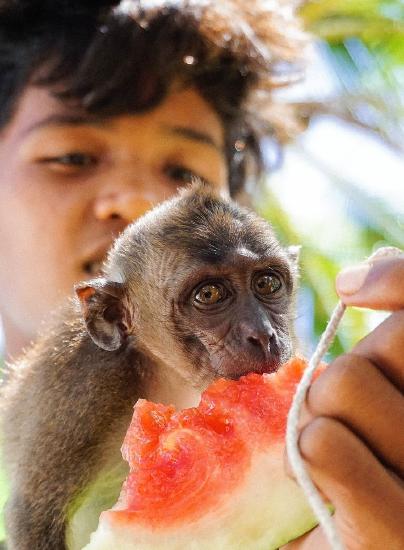
How Humans Are Classified
You probably know that modern humans belong to the species Homo sapiens. Simply what is our place in nature? How are our species classified? A simple classification is represented in Figure \(\PageIndex{two}\). Humans tin can movement on their own and are placed in the animal kingdom. Further, humans belong to the animal phylum known every bit chordates considering nosotros accept a backbone. The human animal has hair and milk glands, so nosotros are placed in the class of mammals. Within the mammal class, humans are placed in the primate order.
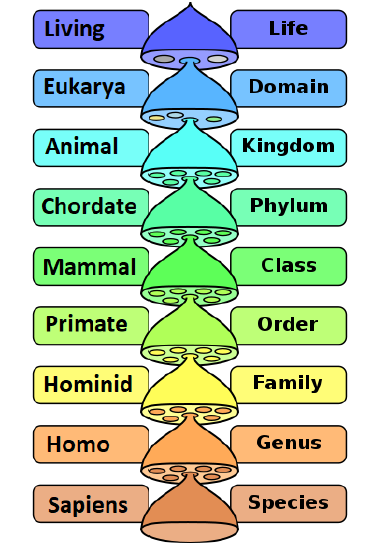
Humans as Primates
Living members of the primate lodge include monkeys, apes, and humans; and any fellow member of this order of mammals is called a primate. At some bespeak in the distant past, we shared ape-like ancestors with all these modern groups of primates. We share between 93 percent and almost 99 percentage of our DNA sequences with them, providing hard evidence that we have relatively recent common ancestors. Likewise genes, what traits practice we share with other primates? Primates are considered generalists among mammals. A generalist is an organism that can thrive in a broad variety of environmental conditions and make use of a variety of different resources, such every bit consuming many different types of food. Although primates showroom a wide range of characteristics, there are several traits that are shared by most primates.
Primate Traits
Primates take five digits (fingers or toes) on each extremity (hand or foot). The fingers and toes take nails instead of claws and are covered with sensitive tactile pads. The thumbs (and in many species the big toes equally well) are opposable, significant they tin be brought into opposition with the other digits, assuasive both a power grasp and a precision grip. Yous can see these features of the primate extremities in the capuchin monkey pictured beneath.
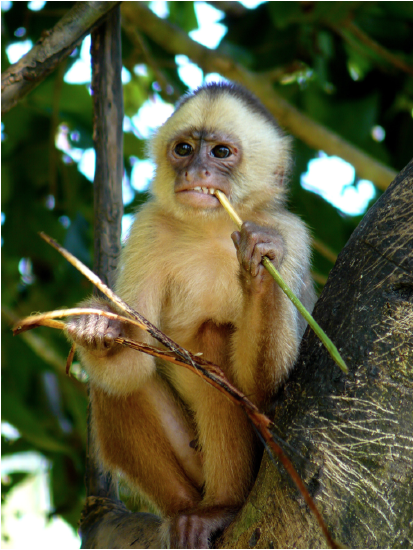
The primate body is more often than not semi-cock or cock, and primates have ane of several modes of locomotion, including walking on all four legs (quadrupedalism), vertical clinging and leaping, swinging from branch to co-operative in trees (brachiation), or walking on ii legs (bipedalism), the concluding of which applies simply to our own species today. The primate shoulder girdle has a collar bone (clavicle), which is associated with a broad range of motion of the upper limbs.
Relative to other mammals, primates rely less on their sense of smell. They accept a reduced snout and relatively small area in the brain for processing olfactory (odour) information. Primates rely more than on their sense of vision, which shows several improvements over that of other mammals. Most primates can see in colour. Primates also tend to have large eyes with forward-facing placement in a relatively flat confront. This results in an overlap of the visual fields of the 2 eyes, allowing stereoscopic vision, or 3-dimensional, vision. Other indications of the importance of vision to primates are the protection given to the eyes by a complete bony eye socket and the big size of the occipital lobe of the brain where visual information is processed.
Primates are noted for their relatively big brains, loftier degree of intelligence, and circuitous behaviors. The part of the brain that is especially enlarged in primates is the cerebrum, which analyzes and synthesizes sensory information and transforms it into motor behaviors appropriate to the environment. Primates tend to have longer lifespans than most other mammals. In particular, at that place is a lengthening of the prenatal catamenia and the postnatal catamenia of dependency of infants on adults, providing an extended opportunity for learning in juveniles. Virtually primates live in social groups. In fact, primates are among the near social of animals. Depending on the species, developed nonhuman primates may live in mated pairs or in groups of upward to hundreds of members.
Life in the Trees
Scientists think that many primate traits are adaptations to an arboreal, or tree-domicile, lifestyle. Primates are thought to have evolved in trees, and the majority of primates all the same live in trees. For life in the trees, the sense of vision trumps the sense of aroma, and 3-dimensional vision is especially important for grasping the adjacent branch or limb. Having mobile limbs, a expert grip, and manual dexterity are matters of life and expiry when one lives high above the ground. While some modernistic primates are mainly terrestrial (ground-abode) rather than arboreal, all primates possess adaptations for life in the trees.
Figure \(\PageIndex{iv}\) shows the present distribution of nonhuman primates around the world. Tropical forests in Key and Southward America are home to many species of monkeys, including the capuchin monkey pictured to a higher place. Onetime World tropical forests in Africa and Asia are domicile to many other species of monkeys, including the crab-eating macaque pictured higher up, as well as all modernistic apes.

Humans as Hominids
Who are our closest relatives in the primate gild? Nosotros are placed in the family called Hominidae. Any member of this family is called a hominid. Hominids include four living genera: chimpanzees, gorillas, orangutans, and humans. Among these four genera are simply seven living species: two in each genera except humans, with our sole living species, Homo sapiens. The Orangutan mother pictured in figure \(\PageIndex{5}\) cradling her child shows how similar these hominids are to united states of america.
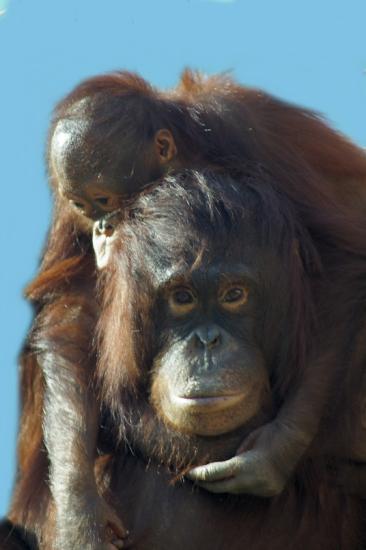
Hominids are relatively large, tailless primates, ranging in size from the bonobo, or pygmy chimpanzee, which may weigh as little as thirty kg (66 lb), to the eastern gorilla, which may weigh over 200 kg (440 lb). Most modern humans fall somewhere in between that range. In all species of hominids, males are somewhat larger and stronger, on average, than females, but the differences may not be great. Except for humans, hominids are mainly quadrupedal, although they can become around bipedally if need exist to get together food or nesting materials. Humans are the but habitually bipedal species of living hominids.
The Human Genus
Within the hominid family, our species is placed in the genus Human being. Our species, Homo sapiens, is the only living species in this genus. Several earlier species of Human existed but have since gone extinct, including the species Homo erectus. An creative person's reconstruction of a Human being erectus individual is shown in figure \(\PageIndex{half dozen}\).
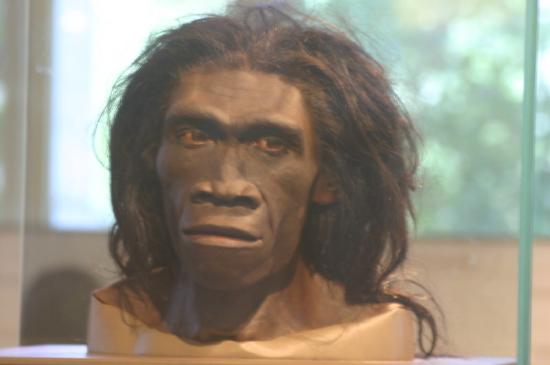
Past well-nigh 2.8 one thousand thousand years ago, early Homo species such every bit Human erectus were probably nearly as efficient at bipedal locomotion as modern humans. Relative to quadrupedal primates, they had a broader pelvis, longer legs, and arched anxiety. However, from the cervix up, they were still quite different from us. They typically had bigger jaws and teeth, a sloping forehead, and a relatively pocket-sized brain.
Homo sapiens
During the roughly ii.8 meg years of the evolution of the Homo genus, the remaining features of Human sapiens evolved. These features include:
- small forepart teeth (incisors and canines) with relatively large molars, at least compared to other primates.
- a subtract in the size of the jaws and face, and an increase in the size of the attic, forming a nearly vertical brow.
- a tremendous enlargement of the encephalon, particularly in the cerebrum, which is the site of higher intellectual functions.
The increase in brain size occurred very rapidly as far as evolutionary change goes, between about 800,000 and 100,000 years agone. During this menstruation, the size of the encephalon increased from about 600 cm3 to about 1400 cm3 and the primeval Homo sapiens appeared. This was also a period of rapid climate change, and many scientists think that climate modify was a major impetus for the evolution of a larger, more complex brain. In this view, every bit the environment became more than unpredictable, bigger, "smarter" brains helped our ancestors survive. Paralleling the biological development of the brain was the development of culture and engineering as behavioral adaptations for exploiting the environs. These developments, fabricated possible by a big brain, allowed mod humans and their recent ancestors to occupy well-nigh the unabridged world and get the dominant land animals.
Our species Homo sapiens is the most contempo iteration of the bones primate body program. Because of our big, complex brain, nosotros clearly have a much greater capacity for abstract thought and technological advances than any other primate, even chimpanzees who are our closest living relatives. Nonetheless, it is important to recognize that in other ways, we are not as good as other living hominids effectually the globe. Nosotros are physically weaker than gorillas, far less agile orangutans, and arguably less well-mannered than bonobos.
Imagine squeezing through a seven-inch slit in rock to enter a completely dark cave total of lots and lots of one-time bones. It might sound like a nightmare to most people, but information technology was a necessary role of a recent exploration of human origins in S Africa every bit reported in the New York Times in September 2015. The cave and its basic were actually start discovered by spelunkers in 2013, who reported it to paleontologists. An international research project was soon launched to explore the cave. The researchers would somewhen conclude that the cavern was a hiding place for the dead of a previously unknown early species of Man, whom they gave the name Human naledi. Members of this species lived in South Africa around 2.five to ii.viii million years agone.
Man naledi individuals were most 5 feet tall and weighed around 100 pounds, and so they probably had no trouble squeezing into the cave. Modernistic humans are considerably larger on average. In guild to call back the fossilized basic from the cave, six very slender female researchers had to be found on social media. They were the only ones who could fit through the crack to admission the cave. The piece of work was difficult and unsafe but also incredibly heady. The site constitutes one of the largest samples for any extinct early Homo species anywhere in the world, and the fossils represent a completely new species of that genus. The site too suggests that early on members of our genus were intentionally depositing their dead in a remote place. This behavior was previously thought to be limited to later on humans.
Like other early Man species, Homo naledi exhibits a mosaic of quondam and modernistic traits. From the neck down, these early on hominins were well adapted for upright walking. Their feet were nearly duplicate from modern human feet (encounter image beneath), and their legs were too long like ours. Homo naledi had relatively small front teeth just likewise a small brain, no larger than an boilerplate orange. Clearly, the spurt in brain growth in H omo did not occur in this species.

Sentinel the news for more heady updates nearly this early species of our genus. Paleotontolgists researching the cave site judge that there are hundreds if not thousands of fossilized bones nevertheless remaining in the cave. In that location are sure to exist many more discoveries reported in the news media about this extinct Homo species.
Review
- Outline how humans are classified. Name their taxa, starting with the kingdom and ending with the species.
- List several primate traits. Explicate how they are related to life in the copse.
- What are hominids? Depict how living hominids are classified.
- Talk over species in the genus Man.
- Relate climatic changes to the evolution of the genus Human being within the last one thousand thousand years.
- What is the significance of the fact that we share 93 to 99 percent of our DNA sequence with other primates?
- Which species practise you recall we are more likely to share a greater amount of DNA sequence with — nonprimate mammals or nonmammalian chordates? Explain your answer.
- What is the relationship between shared Deoxyribonucleic acid and shared traits?
- Compared to other mammals, primates accept a relatively pocket-size surface area of their brain dedicated to olfactory processing. What does this tell you about the sense of smell in primates compared to other mammals? Why?
- The function of the brain in primates that is specially enlarged is the:
- cerebrum
- cerebellum
- clavicle
- brainstem
- Why do you think information technology is interesting that nonhuman primates can use tools?
- True or False. All primates are primarily quadrupedal.
- Truthful or False . Man erectus was in the aforementioned family as mod humans.
- True or False. Humans are superior in all ways to other primates.
- Explicate why the discovery of Human being naledi was exciting.
Explore More than
Attributions
- Child and monkey, public domain via piqsels
- Human taxonomy by Suzanne Wakim dedicated to the public domain is based on biological classification by Peter Halasz, public domain via Wikimedia Commons
- White-fronted Capuchi Monkey by WolfmanSF, licensed CC Past 2.v via Wikimedia Commons
- Non-human primate range by Jackhynes dedicated to the public domain via Wikimedia Commons
- Orangutan mother and baby by Bonnie U. Gruenberg, CC BY-SA three.0 via Wikimedia Eatables
- Homo erectus by Ryan Somma, CC BY-SA ii.0 via Flickr
- Pes of Homo naledi past W. Due east. H. Harcourt-Smith, Z. Throckmorton, K. A. Congdon, B. Zipfel, A. South. Deane, M. Southward. M. Drapeau, S. E. Churchill, L. R. Berger & J. M. DeSilva,
- Licensed CC BY four.0 via Wikimedia Commons
- Text adapted from Man Biology by CK-12 licensed CC Past-NC 3.0
What Domain Are Humans In,
Source: https://bio.libretexts.org/Bookshelves/Human_Biology/Book:_Human_Biology_%28Wakim_and_Grewal%29/02:_Introduction_to_Human_Biology/2.4:_The_Human_Animal
Posted by: richardsonnounkilthe.blogspot.com


0 Response to "What Domain Are Humans In"
Post a Comment